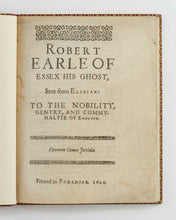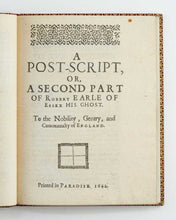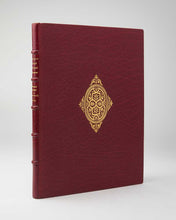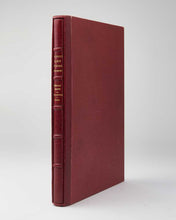
Handsomely bound by Sangorski & Sutcliffe
[SCOTT, Thomas, attributed.] Robert Earle of Essex his ghost, sent from Elizian: to the nobility, gentry, and communaltie of England. “Printed in Paradise” [i.e. London: John Beale?]. 1624.
Two parts in one vol., small 4to. 20th-century red morocco signed by Sangorski & Sutcliffe, London, boards with gilt lozenge at centres, spine with raised bands lettered directly in gilt, gilt turn-ins, gilt edges, house in a red morocco and cloth slipcase; pp. [2], 18, [2 (blank)], [2], 11, [1 (blank)], woodcut initials, typographic headpieces; first and final leaf lightly dust-soiled, otherwise very good; bookplates of Walter T. Shirley II (1933-1992), American real estate developer to front pastedown, and of the Fox Pointe Collection to front free endpaper.
First edition, very rare, of this anonymous attack on the proposed “Spanish Match”, the marriage negotiations between the future Charles I and the Infanta Maria Anna of Spain, thinly disguised as an autobiographical sketch of the second Earl of Essex.
Attributed to the radical Protestant polemicist Thomas Scott (c. 1580-1626), this anti-Spanish pamphlet denounced the protracted and deeply unpopular diplomatic effort to unite Prince Charles (later Charles I) with the Catholic daughter of Philip III of Spain. Negotiations for the match, pursued between 1614 and 1623, became a lightning rod for debates over England’s foreign policy and religious identity during the reign of James VI & I, fuelling widespread fears of a Catholic resurgence and the betrayal of Protestant values.
The pamphlet takes the form of a posthumous speech delivered by the ghost of Robert Devereux, second Earl of Essex (executed for treason in 1601), from the Elysian Fields. By chronicling his own life and experiences, the ghost warns of Spanish malice and duplicity, and frames the match as a threat to the very soul of the English state. The second part, titled “A Post Script”, continues the polemic, recounting in vivid detail “cruell plots… practised in my time on earth, by the King and State of Spaine, against the Queen and State of England”. These include references to the atrocities recorded by Bartolomé de las Casas against the “poore naked Indians in America”; the 1570 papal bull Regnans in Excelsis, which excommunicated Elizabeth I; the queen’s imagined poetic “Answere” to that bull in 68 lines of rhymed verse (supplied, Essex says, because “you have not else-where seene it”); and a catalogue of attempted assassinations and conspiracies (Throckmorton, Parry, Babington, Dr. Lopez, Yorke and Williams) culminating in the defeat of the Spanish Armada in 1588 and, “since my time on earth”, the Gunpowder Plot of 1605, “hatched in hell” and “consulted on and approved of in the Spanish King’s court”.
The text includes two sonnets – one ascribed to King James and “received” by Essex, the other supposedly translated from the original by the French Calvinist theologian Theodore Beza (1519-1605) – both of which are almost certainly apocryphal.
ESTC S101222 (in this edition A2r line 10 ends: “parti-”). Freeman, Bibliotheca Fictiva (2nd edition) 381.1.
#2122555







